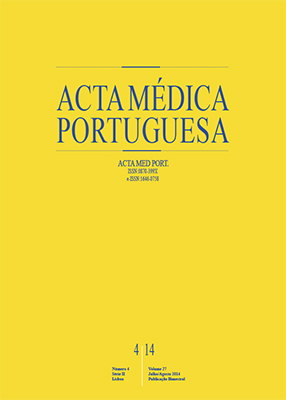Pulmonary Aspergilloma Surgery: a Mono-Institutional Experience
DOI:
https://doi.org/10.20344/amp.4875Abstract
Introduction: Pulmonary aspergiloma or mycetoma is a saprophytic colonization of a preexisting cavity by aspergilloma. Surgical resection is the only effective long-term treatment, but remains controversial because of the high rate of complications in the perioperative and postoperative time.Objectives: Analysis of the experience of a Cardiothoracic Surgery Center for the treatment of pulmonary aspergilloma and evaluation of the prognostic factors after surgery.
Material and Methods: Retrospective analysis including all the patients with a diagnosis of pulmonary aspergilloma submitted to surgery for a 10 years period, in a single institution (June 2001-June 2011).
Results: The study included 22 patients (18 men) with a mean age of 51.0 + 17.4 years. Of them, 46% were smokers, 41% were alcoholic and 50% had a previous history of tuberculosis. Most of the patients had a complex aspergilloma (73%) and 17% a simple aspergilloma. The most common presentation was hemoptysis (50%). The common surgical procedure performed was atypical lung resection in 55%, lobectomy in 27% and pneumectomy in 9%. Two patients were submitted to thoracoplasty. There was one operative death (5%). Postoperative complications occurred in 36% and the most frequent were pneumothorax (18%) and empyema (18%). The mean follow-up period was 52 months (3 - 116) and the 5 years mortality rate of 35%. Of them, 4 patients died because of non- related causes and 3 were immunosuppressed patients. The mortality was 40% in the group of complex aspergilloma and 33% in the group of complex aspergilloma.
Discussion: The most common surgical procedure performed was atypical lung resection. The postoperative complications rate was similar to previous studies.
Conclusion: Surgical resection of aspergilloma presents a low morbidity and mortality. Therefore, for patients with lung function preserved, it is the preferred treatment.
Keywords: Aspergillus; Pulmonary Aspergillosis/surgery.
Downloads
Downloads
Published
How to Cite
Issue
Section
License
All the articles published in the AMP are open access and comply with the requirements of funding agencies or academic institutions. The AMP is governed by the terms of the Creative Commons ‘Attribution – Non-Commercial Use - (CC-BY-NC)’ license, regarding the use by third parties.
It is the author’s responsibility to obtain approval for the reproduction of figures, tables, etc. from other publications.
Upon acceptance of an article for publication, the authors will be asked to complete the ICMJE “Copyright Liability and Copyright Sharing Statement “(http://www.actamedicaportuguesa.com/info/AMP-NormasPublicacao.pdf) and the “Declaration of Potential Conflicts of Interest” (http:// www.icmje.org/conflicts-of-interest). An e-mail will be sent to the corresponding author to acknowledge receipt of the manuscript.
After publication, the authors are authorised to make their articles available in repositories of their institutions of origin, as long as they always mention where they were published and according to the Creative Commons license.









